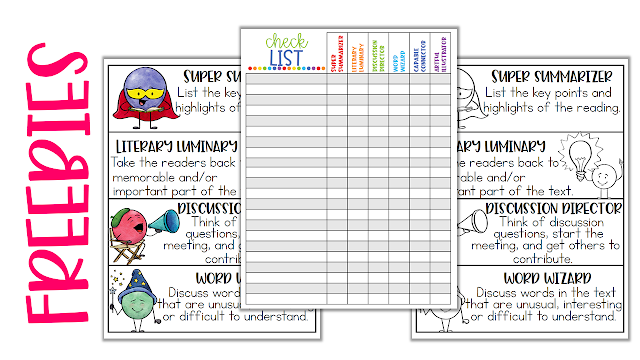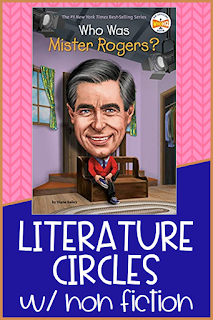How does a literature circle work?
A literature circle helps to guide readers to dig deeper into a text independently. They are a great way to foster 21st-century skills such as: critical thinking, creativity, collaboration, communication, technology literacy and much more!
One component of literature circles is having the “workload” is shifted from the teachers to the students as they become more independent and work in small groups. Each group member is assigned one of 6 roles:
- The Super Summarizer lists the key points and highlights of the reading.
- The Literary Luminary takes the readers back to memorable and/or important sections of the text.
- The Discussion Director thinks of discussion questions, starts the meeting, and get others to contribute.
- The Word Wizard finds and discusses words in the text that are unusual, interesting, or difficult to understand.
- The Capable Connector makes connections to the text (text-text, text-self, text-world)
- The Artful Illustrator finds or creates images to represent a significant scene or idea from the reading.
Getting Started
It is important to begin by modeling the roles for the students and allowing them to have time for guided practice before they are ready to be independent with literature circles.
Once you have selected an article of text, it is time to assign roles. This can be done in a variety of ways: students can pick, the teacher picks, and sometimes we use a random name generator to choose. I keep a checklist to keep track of who has what role so everyone has a turn. You can also use the notes section of Google Slides to type student’s names as a reminder for which role they have.
It is important for students to know what role they have when reading so they know what information they should be looking for. I assign each group a set of literature circle Google Slides and then each student works on their own slide respectively. Students can add to their assigned slides as they read or when they are done. Whatever works best for individual students!
When reading a chapter book, we do a literature circle for each chapter and switch roles when moving onto the next chapter.
Literature Circle with a Book: Who Was Mister Rogers?
Who doesn’t love Mister Rogers?! Who Was Mister Rogers is part of the “Who Was” series which currently has 182 titles! The book tells about Mister Rogers’ journey from childhood to becoming America’s favorite neighbor.
This is a great non-fiction book to use when introducing literature circles to students. It has short chapters full of information for each literature circle role!
Literature Circles with Articles:
During my intervention block, I don’t always have time to commit to a chapter book; so I have been using literature circles regularly with articles! My go-to resource for free articles is Readworks.org. The resources and possibilities are endless!
You can print paper copies or assign them to students electronically. There are optional comprehension activities and “Article-A-Day” sets that can help students to build background knowledge on a specific topic.
Here is an example of a literature circle using an article. Rather than using page numbers, we numbered the paragraphs to reference and students switch roles after each article.
Putting it All Together:
Once everyone has read their chapter or article, it is time to work individually on their role in the literature circle. When everyone is ready it is time to begin! The Discussion Director is responsible for facilitating the conversation and getting things started. Typically they will be in charge of the Google Slides presentation and clicking to the next slide.
The Super Summarizer has the first slide so they will give their summary and then the next person will go. As each person takes a turn, students can comment on what the speaker has said, ask a question, or add additional information. This process repeats itself until the Artful Illustrator closes out the literature circle by sharing what they have created.
Additional Resources:
The “Who Was” series has a website called Who HQ This site features links to a free lesson plan for educators using the books. The home page also has a continually changing Who am I? “Pop Quiz”!
Google Slides Bonus: When students use the Google Slides verion they are able to use the speech to text option found in the “format” tab.
Click here to grab your own copy of this Literature Circle resource! It comes with both a Google Slides and a paper version of the Literature Circles as well as role explanations.
For a limited time only check out this freebie: a checklist for Literature Circle roles along with cards (that can be used as bookmarks) explaining each role. You will have "View Only" access to the file to be sure to go to File > Make a Copy.









